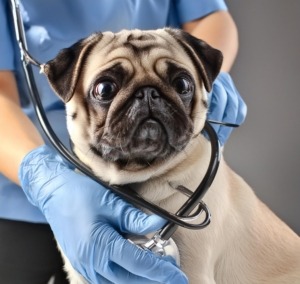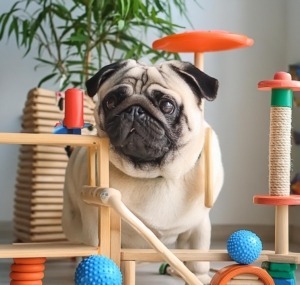Last updated on October 24th, 2024
Here’s an overview:
An Understanding of the Importance of Pug-Specific Health Requirements
Decoding the Pug’s Genetic Health Blueprint
Essential Nutrition for Optimal Pug Health
Recognizing the Signs: Common Pug Health Issues
Tackling Respiratory Problems in Pugs
Preventing and Managing Skin Conditions in Pugs
The Battle Against Obesity: Keeping Your Pug Fit
Caring for Your Senior Pug: Age-Related Health Considerations
Eyes Wide Open: Pug Eye Health
Dental Do’s and Don’ts for Pug Oral Hygiene
Vaccinations and Preventive Care for Pugs
Creating a Pug-Friendly Home Environment
A Complete Guide to Pug Grooming
Emergency Preparedness: When Your Pug Needs Urgent Care
Incorporating Holistic Approaches into Pug Healthcare
Building a Support System: Working with Vets and Pug Communities
Solutions and Treatments: Pug Health Problems Addressing Effectively
An Understanding of the Importance of Pug-Specific Health Requirements
These peculiar looking dogs have very unique physical features which make them require special healthcare attention. Flat faces are prone to brachycephalic syndrome leading to respiratory challenges. Also, their bulgy eyes are susceptible to injuries and infections. Obesity is a common issue hence their eating patterns should be understood by anyone who keeps them since it implies that they have specific dietary needs. These issues once identified can greatly change the lives of these adorable snub-nosed companions. Proper preventative care and prompt medical attention for breed-specific issues are integral to nurturing a healthy, happy Pug.
Decoding the Pug’s Genetic Health Blueprint
There are several health problems that pugs might develop due to their inherited conditions. Most of these concerns arise from their peculiar physical attributes. For example, they have brachycephalic skulls that predispose them to breathing difficulties and other respiratory complications. Additionally, certain hereditary diseases may affect Pugs including hip dysplasia, Pug Dog Encephalitis (PDE), and eye problems such as corneal ulcers. Understanding these genetic markers can play a crucial role in identifying potential health challenges at an early stage thus enabling timely intervention. With this in mind, genetic testing is becoming more popular amongst those who own pugs as it helps one predict concerns before they occur hence aiding in addressing them effectively. It allows individualized treatment plans which are important when taking care of these sociable pets.
Essential Nutrition for Optimal Pug Health
Good nutrition is fundamental to any pug’s well-being. Their food should consist of proteins, fats, and carbohydrates which suit their individual requirements. High-quality proteins help maintain muscles while fats boost energy production and keep skin looking great as well as coats appearing sleeker all the time. Carbohydrates should be obtained from digestible foods like whole grains or vegetables to provide energy as well as fiber content.
- Make sure you provide enough amount of essential fatty acids like omega-3 and omega-6 which help against inflammation and support joint health especially for dogs that usually suffer from hip dysplasia.
- To prevent obesity that affects many pugs regulate the calorie intake with portion controlled meal sizes.
- Include immune supporting vitamins and minerals particularly vitamin A for their eyes given its affinity to eye issues in this breed.
- They should also always have access to clean water so they do not become dehydrated since this would impair digestion and kidney function.
Consult a vet on a diet plan tailored for your pug based on factors such as age, weight, and activity level so that it can grow healthy.
Recognizing the Signs: Common Pug Health Issues
In most cases, because of their unique features, pugs are susceptible to a number of health problems. Knowing about these common illnesses can help in identifying them early and treating them:
- Brachycephalic Syndrome which is caused by the shortness of their snouts – exhibits signs such as wheezing or snoring.
- Skin inflammations may be noticed by excessive scratching or sore spots since dirt and moisture can build up in their skin folds.
- Eye conditions range from injuries to conjunctivitis, dry eye syndrome and corneal ulcers due to the bulging eyes experienced by pugs.
- Obesity watch out for pugs’ weight because they tend to gain it easily thereby resulting into other medical issues such as arthritis.
- Dental Problems keep an eye on their teeth as the crowded nature of a pug’s mouth predisposes it to dental ailments.
To preclude these diseases from being severe, one should monitor proactively and take pets for routine vet visits.
Tackling Respiratory Problems in Pugs
Mainly because they are brachycephalic (short-faced), pugs often experience respiratory difficulties. Snoring, wheezing and labored breaths could indicate breathing challenges. The following measures should be taken:
- Regular Checks: observe your pet carefully for any changes in its breathing or noises made when inhaling or exhaling.
- Weight Control: Maintain healthy weights with your doggie so that its respiratory system does not get strained.
- Controlled Exercise: do not overdo play sessions or exercise so that you can avoid straining these systems further than what they are already experiencing.
- Climate Change Awareness: Keep Pugs cool always as this breed is prone to overheating faster leading to more skin problems.
- Proper Bedding: Use beds that slightly elevate head position making breathing easier while sleeping
- Veterinarian Visits: Find a vet who specializes in brachycephalic breeds and make regular appointments
Timely addressing of these issues can greatly improve the pug’s quality of life.
Preventing and Managing Skin Conditions in Pugs
Wrinkles, short hair coat makes pugs prone to suffering from variety of skin conditions for instance allergies and infections. These measures involve gently wiping their wrinkles with a damp cloth then drying them well to prevent bacteria buildup. This may be seen by providing a well-balanced diet as well as introducing hypoallergenic dog food brands. One ounce of prevention is worth a pound of cure so do not forget regular checkups with a veterinarian. Also, keep them cool because they can easily overheat which worsens skin problems. To control pug’s skin problems, groom it regularly and use proper shampoos that are recommended by a veterinarian.
The Battle Against Obesity: Keeping Your Pug Fit
Owners should do the following to maintain the right weight for their pets:
- Proper Nutrition: feed balanced diets without overfeeding; measure foods served during meals or snacks.
- Encourage Regular Exercise: Make sure there are daily walks or playtime as this breed needs moderate exercise in order to stay fit.
- Health Check-Ups: Regular visits to your vet will help you monitor weight changes as well as adjust diet or exercise routines accordingly.
- Respect Brachycephalic Limitations: Do not push pugs too hard, especially when it is hot outside because it has breathing difficulties due to its flat face shape.
- Implement Weight Management Plans: A diet that incorporates change and increase in physical activity may have to be created in collaboration with a veterinary doctor if obesity exists.
An ideal body mass matters for general wellbeing and long life expectancy of all pugs.
Caring for Your Senior Pug: Age-Related Health Considerations
Pregnant women are more likely to develop gestational diabetes if they gain too much weight before or during pregnancy.
- Regular Veterinary Check-ups: Such visits should be scheduled twice in a year so that any health problems can be detected early enough by doctors.
- Diet Management: They may need reduced calorie intake in order to maintain ideal body weight and healthy joints, considering lower calorie needs and potential for obesity.
- Tooth Care: Aged pugs ought to be attended to about their teeth.
- Exercise: To maintain a good health and mobility, keep up with gentle exercise.
- Joints: Arthritis should be addressed by making use of proactive joint supplements or anti-inflammatory drugs.
- Vision and Hearing: because most old pugs usually have poor eyesight as well as reduced hearing capacities .
- Comfortable Living Space: So that their limited movements can easily be accommodated, provide them with a warm accessible living area.
For this reason, the quality of life for senior pugs in golden age can still be maintained if you consider these points.
Eyes Wide Open: Pug Eye Health
Because of the prominence of its eyeballs and facial structure, various eye health concerns are common among Pugs. Irritation, redness or excessive tearing needs constant monitoring from owners. Regular veterinary check-ups help detect conditions like entropion where the eyelid rolls inward or keratoconjunctivitis sicca commonly known as dry eye at an early stage. Preemptive measures such as staying away from areas that are too dusty can prevent irritation or injury. Also gently clean your Pug’s eyes with a soft damp cloth to remove any debris. By being proactive in caring for it you could minimize the risk of serious eye complications thus ensuring your Pug has clear and healthy vision.
Dental Do’s and Don’ts for Pug Oral Hygiene
Do
- Brush your dog’s teeth often using dog toothpaste.
- Give dental chews which reduce plaque and tartar buildup.
- Plan annual dental check-ups by vets with you dog’s vet
- Start brushing your pup early on so that they get used to it.
Don’t
- Pay no attention to bad breath because it could indicate possible dental problems in dogs especially cavities (Girman 1997).
- Use human toothpaste since it is poisonous to pets more so dogs (Branam and Sutherland 2010).
- Allow your dog to chew hard toys as this may cause a broken tooth (Branam and Sutherland 2010).
- Avoid regular vet visits as these are the times when professionals do cleanings (Girman 1997).
Vaccinations and Preventive Care for Pugs
Pugs, like all dogs, require vaccination at the right time to protect them from disease such as rabies, distemper and parvovirus. A veterinarian will then set up a program based on the specific pug keeping in mind its age, health status and risk factors.

Prevention remains as crucial in pugs. These canines are normally prone to obesity hence it is important that they take balanced diets with exercise programs alongside. A comprehensive health approach involves routine check-ups, oral care practices and parasite control. Furthermore, owners must be aware of brachycephalic syndrome in pugs because it affects their ability to breathe.
Creating a Pug-Friendly Home Environment
Their living space must cater to their unique needs if optimization of the health of pugs is a priority. Start by:
- Temperature Control: Pugs do not tolerate drastic temperature changes so make sure that indoor climate is warm enough without being overheated or too cold.
- Accessibility: Minimize jumping or climbing since some pugs develop joint problems; provide ramps or steps where necessary.
- Flooring: Pug-friendly flooring should be slip-resistant because they can easily fall down due to clumsiness.
- Proper Beddings: Orthopedic beds should therefore be preferred for them so that they can support their short yet heavy bodies well.
- Air Quality: Remove excessive dust or smoke from your premises so as to keep good ventilation because their respiratory organs are hyper-sensitive.
- Toxic-Free Environment: For instance most household cleaning agents but also poisonous plants should out of reach from these pets since they are curious animals.
A Complete Guide to Pug Grooming
When grooming your pug, brush it regularly to remove loose fur and reduce shedding. Use a gentle grooming mitt or soft bristle brush to go through their skin. Every few weeks, pugs need to be bathed with a dog-specific shampoo to maintain healthy skin. Do not forget about cleaning the face wrinkles with a wet towel.
- You should brush your Pug 1-2 times per week.
- Use a soft bristle brush or grooming mitt.
- Bathe your Pug every 3-4 weeks
- Clean facial wrinkles with a damp cloth daily
Check and clean their ears weekly for wax build-up and ear infections. Trim their nails on time so they don’t grow too long causing walking problems. Dental hygiene is critical; ensure teeth are brushed multiple times each week as periodontal diseases can occur. After bathing make sure you dry off your Pug completely before they catch cold.
Emergency Preparedness: When Your Pug Needs Urgent Care
Owners must know when immediate action is necessary for their pugs. These include breathing difficulties, excessive vomiting, uncontrolled bleeding, and seizures. Always keep:
- List of emergency vet contacts
- Basic first aid kit for dogs
- Transportation plan in emergencies
Stay calm but act quickly in an emergency situation. If your pet has swallowed something poisonous, contact the veterinarian or poison control center immediately: For severe trauma, minimize movement and carefully transport your pet so as not to cause further injury. Consultations with vets should always be made when there is any sudden onset or unexplained illness.
Incorporating Holistic Approaches into Pug Healthcare
Holistic methods can complement traditional veterinary care in optimizing pug wellness. Think of:
- Nutrition: Provision of balanced species-appropriate diets that support overall health
- Exercise: Regular low-impact activities that enhance cardiovascular function and joint health.
- Mental Stimulation: Interactive toys and training as means of preventing cognitive decline and boredom.
- Alternative Therapies: Acupuncture, chiropractic care or massage for management of chronic diseases
- Environmental Enrichment: A safe, stimulating environment helps to minimize stress, which is a factor in health problems.

This calls for an individualized plan taking note of each pug’s peculiarities and lifestyle issues.
Building a Support System: Working with Vets and Pug Communities
Caring for Pugs involves putting together a trustworthy network that includes experienced vets and active pug communities. This cooperation brings about the following:
- Veterinary Partnerships: Find a trusted vet with knowledge in brachycephalic breeds before you need one. Regular check-ups are essential as well as immediate attention to respiratory symptoms.
- Pug Clubs and Organizations: Join your local or online pug clubs for useful information about breed-specific concerns and reliable care tips.
- Health Workshops and Seminars: Participation in workshops can improve knowledge on pug nutrition, exercise needs, and preventive care practices.
- Digital Forums and Social Media: Online platforms can be used to share experiences when it comes to finding support during stressful times such as health crises or learning from others’ ways of managing their furry friends’ health conditions.
Through these channels, dog owners get access to information resources as well as moral support that ensures their pets receive optimum care possible.
Solutions and Treatments: Pug Health Problems Addressing Effectively
It is important to have regular visits to a veterinary doctor for pugs to ensure their good health. Such common illnesses as brachycephalic syndrome, for instance, will be detected early through:
- Weight management that reduces respiratory distress.
- If it is necessary, surgery may help improve the airway function.
Skin infections require:
- Medicated shampoos
- Antibiotics or fungicides
Obesity needs a program which should include:
- Calculated changes in diet
- Regular physical activities
Eye issues require:
- Preventive measures against damage
- Proper medical interventions for infections and ulcers.
Joint issues gain from:
- Glucosamine supplements with regards to joints.
- Controlled low impact exercises
In all situations, it is crucial to cooperate with a vet doctor so that they can plan for the well-being of the dog.





